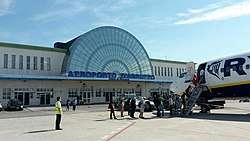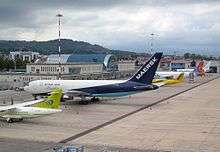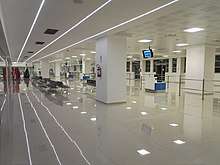Abruzzo Airport
Pescara Abruzzo Airport (IATA: PSR, ICAO: LIBP) is an airport located in Pescara, Italy. It is located approximately 4 km (2.5 miles) from the centre of Pescara, about 180 km (112 miles) from Rome, a 2-hour drive by car on a motorway across the Appennine mountains. The airport is located on the state road 5 Via Tiburtina Valeria and is well connected to important road (Autostrada A25, Autostrada A14, SS714 Tangenziale di Pescara) and railway connections (Rome–Sulmona–Pescara railway, Adriatic railway).
Pescara Abruzzo Airport | |||||||||||
|---|---|---|---|---|---|---|---|---|---|---|---|
 | |||||||||||
| Summary | |||||||||||
| Airport type | Public | ||||||||||
| Operator | S.A.G.A. S.p.A. | ||||||||||
| Serves | Pescara | ||||||||||
| Elevation AMSL | 48 ft / 15 m | ||||||||||
| Coordinates | 42°26′14″N 014°11′14″E | ||||||||||
| Website | abruzzo-airport.it | ||||||||||
| Map | |||||||||||
 Pescara Abruzzo Airport | |||||||||||
| Runways | |||||||||||
| |||||||||||
| Statistics (2019) | |||||||||||
| |||||||||||
Being the only international airport in the Abruzzo region, it plays a fundamental role for the transportation and aerial connection of the area and for that of neighbouring regions, catching people also from Molise, Marche and the Gargano area.
The airport has seen a steady increase in the number of transit passengers over the years, mainly due to a growth in low-cost airlines and flights. The terminal built in 1996 has been extended in 2011 and recently restructured in 2018.
History
Early years
The history of the airport starts in 1917 when, after the bombing of Pescara by bombers of the k.u.k. Luftfahrtruppen, the aerial component of the Austro-Hungarian Army, along the Via Tiburtina Valeria road a military airfield is built by the Regio Esercito, which arrived on 26 October 1917 with two Farman 14. On 31 July 1918 the 302° Squadron is formed, equipped with biplanes Ansaldo SVA, among the best fighter-bombers of the time.
From 1921, the airport has been named after Pasquale Liberi, an aviator friend of the famous poet Gabriele d'Annunzio. In 1927 the airport was extended to 50 hectares and modernized.
In the 1930s, with the start of commercial aviation, the airline Società Aerea Mediterranea (SAM) started in 1933 a triweekly service from Pescara to Rome Urbe Airport, with an intermediate stop at the airfield of Piana di Bagno near L'Aquila.
After WWII, the first airline to restart commercial service was Società anonima di navigazione aerea transadriatica (Transadriatica), which inaugurated the service Pescara-Roma-Urbe on 5 May 1947 using a Douglas DC-3. At the same time, Transadriatica started another interesting route: Venezia-Ancona-Pescara-Brindisi-Catania. Furthermore, the airline Avio Linee Italiane decided to start a route connecting North to South Italy for the first time: Milan-Pescara-Foggia-Bari-Brindisi.
1960s
Itavia, constituted in 1958 to operate between secondary airports not served by Alitalia, opened its first route Pescara-Roma-Urbe on 15 July 1959 with a 8-seats de Havilland Dove. With the development of Itavia also the number of routes increased between the end of 1960s and beginning of 1970s, including Roma, Milano, Ancona, Crotone, Forlì, Lecce, Bergamo, Bologna, Treviso-Venezia, Catania and Palermo.
1970s
In 1973, the English historian Bruce Barrymore Halpenny, then living in Abruzzo, organised a British Caledonian BAC 111 to take off from Genoa Airport to Pescara to test the feasibility of the approach and landing at Pescara of a large commercial aircraft.[3] With the British Caledonian chief pilot being an ex-RAF pilot and Halpenny (also Ex-RAF) on board this maneuver was successfully accomplished,[3] opening up the airport and the region for tourism.[3] Halpenny then arranged for a British Caledonian BAC 111 to take off from Gatwick Airport, land in Pescara and return to Gatwick, demonstrating the feasibility of [3] commercial flights to the airport.[3]

As of 1 February 1979, Itavia was forced to suspend its flights to Pescara due to the revision of the minimum landing requirements on some Italian airports implemented by ANPAC, the National Association of Civil Aviation Pilots. The raise of the requirements in question (distance to the runway and altitude at which the pilot must decide whether to continue the landing) were dependent on proper radio support (such as ILS, Instrument Landing System) and a clear view to allow the landing of aircraft in conditions of poor visibility. Such instruments were not installed at the time at the airport. Itavia itself was never going to be back at the airport, as it ceased operations in June 1980, after the Ustica disaster.
1980s
After the dark period during which the airport did not have any connection, the situation improved with the reopening of a route to Milano through Ancona, operated by Aermediterranea, a company belonging to Istituto per la Ricostruzione Industriale (IRI) and controlled by Alitalia, which was operated between 1981 and 1983.
From 1984, the flight to Milan Linate Airport was managed by another company of the Alitalia group: Aero Trasporti Italiani (ATI), based in Naples. In 1988, it was the turn of Alitalia itself to operate the much-sought direct connection to Milan, using the modern McDonnell Douglas MD-80 jetliners until 1994.
1990s
Air One was founded as Aliadriatica in 1983 as a flight school and air taxi company for services in Abruzzo. From 1994, it was this company who took operation of the route to Milan.
In 1996, the current terminal opened and the old building was converted for technical and logistical support. The project enabled the airport to offer more comfort and efficiency of service.
Developments since the 2000s
The development of the airport, which has seen an increment of passengers from 114,000 in 2000 to over 600,000 in 2015, is mainly due to the low-cost phenomenon that has affected all of Europe and most small Italian airports, benefiting Pescara.
Today the airport has a catchment area of over 600,000 passengers annually and connects the city of Pescara and the entire region with many Italian and European destinations, in particular with the services offered by the airlines Ryanair and Volotea.
Redevelopment and expansion plans

A series of development works have been carried out between 2008 and 2018 at the airport. Those completed at July 2019 include:[4][5]
- Building of a new arrival hall (completed in September 2018);
- Building of a new departures hall with new gates, bar and toilettes (completed in November 2018);
- Redesign and expansion of the duty-free area (bar, shops, rent a car) to 7.800 m² (from the current 6.300 m²) and placed in the arrival hall (completed in July 2019);
- Retrofitting and regulation works (completed in late 2008);
- Expansion of the apron 2 (completed in January 2009);
- Expansion of the airport to the west (completed in 2011);
- Building of offices and accommodation for the Flight Police Department (completed in May 2014);
- Resurfacing of the runway (completed in March 2017);
- Modernization and redesign of the parking areas (completed in November 2017);
- Building of a Business room (completed in November 2018);
- Renovation of the toilets of departures and domestic arrivals areas;
- The union of domestic and international arrivals halls;
- Modernization of the baggage belts;
- New trim and fittings in the redeveloped areas
- Expansion of the airport security and video surveillance systems;
The master plan of development and modernization of the airport includes further upgrading works of both the airside and landside areas, for an overall cost of 33 Euro million. The works include:[6]
.jpg)
Landside area
- Construction of a plant for the treatment of water;
- The installation of a photovoltaic system on the roof;
- Replacement of the computer infrastructure;
- Renovation of the air conditioning system.
Airside area
- Removal of ex-military structures previously sold to privates, to increase the number of parking spaces for aircraft;
- Construction of two new hangars and a cargo area;
- Construction of new helipads for the law enforcement helicopters and a new small square for the Coast Guard;
- Lengthening of the runway and construction of a new multi-storey garage for cars;
- Rail link.
Currently the building of the old passenger terminal has been converted to a warehouse; it was employed by the airline cargo TNT Airlines up to December 2008 and by Maersk Air until October 2010.
A journalistic investigation carried out in September 2018 revealed that Abruzzo Airport has the cheapest airport parking in Italy.[7]
Airlines and destinations
| Airlines | Destinations |
|---|---|
| Alitalia | Milan–Linate |
| Ryanair | Bergamo, Bucharest, Charleroi, Hahn (ends 30 October 2020),[8] London–Stansted, Malta Seasonal: Prague, Weeze |
| Volotea | Catania Seasonal: Cagliari, Olbia , Palermo |
Statistics
| Year | Passengers | % | Movements | % | Cargo (tons) | % |
|---|---|---|---|---|---|---|
| 1996 | 71,908 | 4,052 | 152 | |||
| 1997 | 72,962 | 2,86 | 4,618 | 13,9 | 195 | 28,3 |
| 1998 | 104 000 | 42,54 | 6,390 | 38,4 | 56 | -71,3 |
| 1999 | 105 500 | 1,44 | 6,310 | 1,25 | 476 | 750 |
| 2000 | 114,024 | 8,08 | 9,940 | 57,5 | 2.851 | 499 |
| 2001 | 153,227 | 34,4 | 6,775 | -31,8 | 3.115 | 9,3 |
| 2002 | 295,875 | 93,1 | 11,559 | 70,6 | 1.913 | -38,6 |
| 2003 | 301,773 | 2,0 | 10,932 | -5,4 | 1.795 | -6,2 |
| 2004 | 334,998 | 10,9 | 10,075 | -7,8 | 2.151 | 19,8 |
| 2005 | 350,447 | 4,7 | 10,339 | 2,6 | 2.390 | 11,1 |
| 2006 | 340,699 | -2,8 | 12,139 | 17,4 | 2.849 | 19,2 |
| 2007 | 371,247 | 9,0 | 12,085 | -0,4 | 3.291 | 15,5 |
| 2008 | 402.845 | 8,5 | 11.128 | -7,9 | 3.339 | 1,5 |
| 2009 | 409.045 | 1,5 | 9.773 | -12,2 | 2.431 | -27,2 |
| 2010 | 461.086 | 12,7 | 7.971 | -18,4 | 2.116 | -13,0 |
| 2011 | 550.062 | 19,3 | 7.827 | -1,8 | 1.472 | -43,7 |
| 2012 | 563.187 | 2,4 | 8.284 | 5,8 | 1.221 | 1,8 |
| 2013 | 548.217 | -2,7 | 8.017 | -3,2 | 721,1 | -40,9 |
| 2014 | 556.679 | 1,5 | 6.738 | -15,95 | 44 | -93,9 |
| 2015 | 613.427 | 10,2 | 10.469 | 55,4 | 42 | -4,2 |
| 2016 | 572.217 | -6,6 | 8.850 | -14,3 | 69,5 | 65,5 |
| 2017 | 667.831 | +16,7 | 15.331 | +73,2 | 52 | -25,2 |
| 2018 | 666.691 | -0,2 | 13.456 | -12,2 | 72 | 38,5 |
| 2019 | 703.386 |
+5,2 | 36.695 |
+63,3 |

Ground transportation
Bus
The airport is connected to the center of Pescara with the TUA (regional public transportation company) bus lines 8 and 38, with which it is possible to reach Piazza della Repubblica, the Bus Terminal serving domestic and international destinations. The bus lines 8 and 38 pass also near the main railway station in the city, Pescara railway station.
The airport is connected to the center of Pescara and Chieti with the TUA Chieti-Pescara line, with which it is possible to reach the university campus "G. D'Annunzio" in Chieti Scalo. The TUA stop is opposite to the pedestrian exit of the airport park on Via Tiburtina Valeria.
Cars
Coming from Rome: from Autostrada A24 take the Chieti-Pescara exit which merges with the SS656 in the direction of Pescara. Then take the exit Sambuceto-Airport and follow signs to the airport.
Coming from Bologna-Ancona: Autostrada A14, exit at Chieti-Pescara Ovest, turn immediately right (twice) to get onto the road SS5 Via Tiburtina Valeria in the direction of Pescara, then drive about 6 km (3.7 miles) until you reach the airport.
Coming from Bari-Foggia: take the Autostrada A14 Chieti-Pescara Ovest exit, turn immediately right (twice) to get onto Strada statale 5 Via Tiburtina Valeria in the direction of Pescara, then drive about 6 km (3.7 miles) until you reach the airport.
Coming from Naples: Autostrada A1 towards Rome, exit at Caianello, follow the signs to Isernia, arrived at Isernia go to Vasto until you see the Autostrada A14 signs. From the Autostrada A14, exit at Chieti-Pescara Ovest, turn immediately right (twice) to join the Strada statale 5 Via Tiburtina Valeria in the direction of Pescara, then drive about 6 km (3.7 miles) until you reach the airport.
Trolley-line
In addition, the airport will soon be served by the new trolley-line currently under construction, which will connect Pescara and its points of reference such as Pescara railway station and other neighboring towns such as Montesilvano and Francavilla al Mare.
See also
References
- "EAD Basic - Error Page".
- Associazione Italiana Gestori Aeroportuali
- Abruzzo – Londra: è quasi una realtà Il Tempo – D'Abruzzo, editor Gianni Letta, 27 Ottobre 1973 – N. 294
- http://pescaraspotters.it/notizie/29-masterplan-e-lavori
- <https://pescaraspotters.it/notizie/72-lavori-di-riqualifica
- http://www.abruzzoairport.com/news.aspx?lnk=r/EkyFHF2cQ=&lang=it
- "Il parcheggio in aeroporto costa più del volo: ecco i più salati (e quelli meno cari)". GQ Italia (in Italian). 4 September 2018. Retrieved 27 September 2018.
- https://www.bbc.com/news/business-53485673
- ASSAEROPORTI - Associazione Italiana Gestori Aeroporti - Dati di Traffico - (r) 2009.
External links
![]()